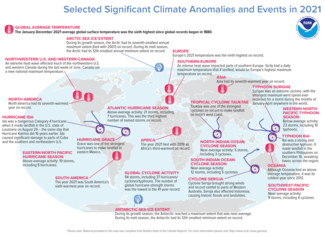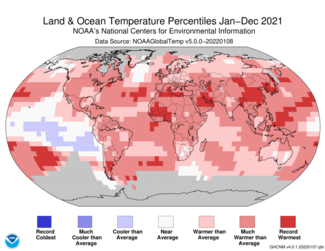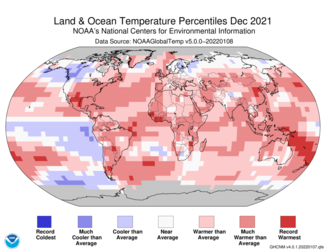2021 was the sixth-warmest year on record for the globe

The global surface temperature for 2021 was the sixth highest since record keeping began in 1880, according to NOAA scientists. In a separate analysis of global temperature data, also released today, NASA has 2021 tying with 2018 as the sixth-warmest year on record. December’s global surface temperature tied with 2016 as the fifth highest in the 142-year record.
This summary from NOAA National Centers for Environmental Information is part of the suite of climate services NOAA provides to government, business, academia and the public to support informed decision-making.
Global Climate Highlights: 2021
Global land and ocean surface temperature: For 2021, the average temperature across global surfaces was 1.51°F (0.84°C) above the 20th-century average. This was the sixth highest among all years in the 1880-2021 record. The year 2021 marks the 45th consecutive year (since 1977) with global temperatures, at least nominally, above the 20th-century average. The nine years spanning 2013 through 2021 rank among the 10-warmest years on record.
For the 21-year span that is considered a reasonable surrogate for pre-industrial conditions (1880–1900), the 2021 global land and ocean temperature was 1.87°F (1.04°C) above the average. The annual global surface temperature has increased at an average rate of +0.14°F (+0.08°C) per decade since 1880; however, since 1981 the average rate of increase is more than twice that rate (+0.32°F / +0.18°C).
The year began in the midst of a cold phase El Niño Southern Oscillation (ENSO) episode across the central and eastern tropical Pacific Ocean, which developed in August 2020. This phase, known as La Niña, tends to cool global temperatures slightly, while the warm phase ENSO (also known as El Niño) tends to boost global temperatures.
The 2021 Northern Hemisphere surface temperature was the sixth highest in the 142-year record at 1.96°F (1.09°C) above the 20th century average. Of note, the Northern Hemisphere land surface temperature was the third highest on record. Only the years of 2016 (second) and 2020 (warmest) were warmer. Meanwhile, the 2021 Southern Hemisphere surface temperature was the ninth highest on record.
Record-high temperatures over land surfaces were measured across parts of northern Africa, southern Asia, and southern South America in 2021. Record-high sea surface temperatures were observed across parts of the Atlantic and Pacific oceans. However, no land or ocean areas were record cold for the year.
Regionally, the annual average temperature departure for Africa tied with 2019 as the third highest on record, behind 2010 (second-warmest) and 2016 (warmest). North America, South America, Europe, and Asia each had an annual temperature that ranked among the nine warmest on record. While Oceania had an above-average annual temperature, 2021 was its coolest year since 2012.
Global ocean heat content (OHC): The upper ocean heat content, which addresses the amount of heat stored in the 0-2000 meters depth of the ocean, was record high in 2021, surpassing the previous record set in 2020. The seven highest OHC have all occurred in the last seven years (2015-2021).
2021 Snow and Sea Ice Information
Northern Hemisphere snow cover: According to NOAA data analyzed by the Rutgers Global Snow Lab, the average annual Northern Hemisphere snow cover extent for 2021 was 9.39 million square miles and the seventh-smallest annual snow cover extent in the 1967-2021 record.
Arctic sea ice extent: Each month in 2021, with the exceptions of September and December, had a monthly Arctic sea ice extent that ranked among the 10-smallest extents for each respective month. However, no month had a record low sea ice extent during the year. When averaging monthly data from the National Snow and Ice Data Center, the average annual sea ice extent in the Arctic was approximately 4.08 million square miles – the ninth smallest annual average sea ice extent in the 1979-2021 record. The last seven years (2015-2021) had an annual sea ice extent that ranked among the 10 smallest on record.
Antarctic sea ice extent: The annual Antarctic sea ice extent was slightly below average at 4.42 million square miles. The months of March, July and August had a monthly extent that ranked among the 10 largest for their respective months. However, the months of October, November and December had a monthly extent that ranked among the four smallest for their respective months. No month had a record low or high sea ice extent during 2021.
2021 Global Tropical Cyclones
The year 2021 had an above-average global tropical cyclone activity with a total of 94 named storms. This value ties with 1994 as the 10th-highest number of named storms in the 41-year record. Despite the above-average number of named storms, there were only 37 hurricane-strength tropical cyclones – the lowest number for global hurricane-strength tropical cyclones on record, one less than the now-second lowest of 38 set in 2009. Of the 37 hurricane-strength cyclones, 16 reached major hurricane-strength, which tied with 1986 as the third lowest on record.
The North Atlantic had 21 named storms, which was the third-highest number of named storms for the basin. The East North Pacific also had an above-average activity for the year, while the West Pacific had a below-average activity. The other basins had near-average activity.
Global Climate Highlights: December 2021
Global land and ocean surface temperature: For December, the average temperature across global land and ocean surfaces was 1.49°F (0.83°C) above the 20th-century average. This value tied with 2016 as the fifth-highest temperature departure from average for December in the 1880-2021 NOAA record.
Regionally, South America’s December temperature departure was the third-highest on record. Africa and Oceania each had a December temperature that ranked among the eight warmest on record. Although North America and Europe both had an above-average December temperature, they each experienced their coolest Decembers since 2016.
Northern Hemisphere snow cover: According to data from NOAA analyzed by the Rutgers Global Snow Lab, the Northern Hemisphere snow cover extent during December was 200,000 square miles above the 1981-2010 average and ranked as the 17th-largest December extent on record. The North American December extent was near average, while the Eurasian snow cover extent was above average and the 13th-largest Eurasian December extent on record.
Arctic sea ice extent: The average Arctic sea ice extent for December was 4.71 million square miles, according to analysis by the National Snow and Ice Data Center (NSIDC) based on data from NOAA and NASA. Although this value was 5.1 percent smaller than the 1981-2010 average, it was the largest December sea ice extent since 2014. December 2021 also marked the 24th consecutive December with below-average sea ice extent.
Antarctic sea ice extent: Antarctic sea ice extent during December was 3.55 million square miles, according to analysis by the NSIDC. This value is 11.6 percent below average and was the third-smallest December extent on record. Only the Decembers of 2016 and 2018 had a smaller extent.
See our full report for a more complete summary of climate conditions and events.



